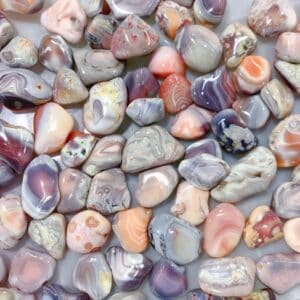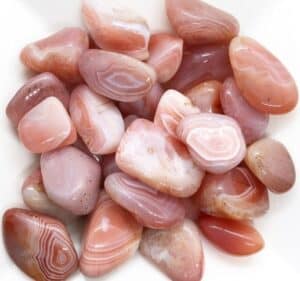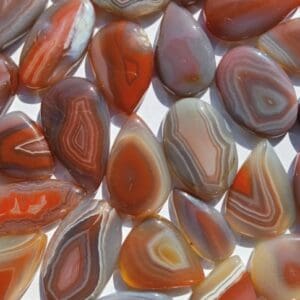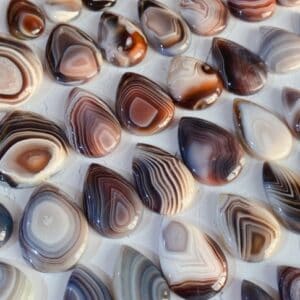Botswana Agates consist primarily of cryptocrystalline silica (mainly Chalcedony) alternating with micro-granular quartz and are easily identified by their tight bands and variety of colors.
It’s fairly common to see Botswana Agate being sold as “Banded Agate” because it’s readily available and the consumer is more comfortable with the name agate, or banded agate. These agates exhibit a rainbow of cool colors like white, grey, and black, and gentle hues of pink, blue, apricot, and light brown.
The easiest way to identify a Botswana Agate would be to pay close attention to the color. Your run-of-the-mill agate won’t have the pastel colors Botswana Agates are known for. Most of the material comes from the Botswana River and you’ll see rock and mineral dealers label the material as such. The overall size of the material can give you a clue as well because most of them are golf ball sized to baseball-sized pieces.
Botswana Agate is very popular among lapidary artists and they fashion them into cabochons and tumbled stones. If you’re looking for more expensive or rare agates then take a look at Fairburn agate, Lake Superior agate, Mexican Crazy Lace agate, and Fire agate.

Types of Botswana Agate
The banding you see in Botswana agate was formed by repeated floods of slow-moving lava, which laid down successive layers of Quartz/Silica. This laid the foundation for large quantities of material located in Botswana.
As you spend time at your local rock and mineral shows you’ll notice there is plenty of this material available and you’ll be to be selective on which pieces you purchase. Look for tight bands, clean colors, and you’ll need to think about orientation if you’re going to turn the material into cabochons.

Pink Botswana Agate
The rarest form of Botswana Agate is Pink Botswana Agate, which is considered the most royal form of agate known to the gem trade. If you’re lucky enough to come across this material you’ll notice the color ranges from light pink to salmon and some pieces will have a hint of red. You want to see tight bands and the color of the bands needs to be a bright white.
If the agates meet these conditions then they will fetch a premium price due to their scarcity.
These are sourced from the Bobonong District of Botswana and the material is limited.

Grey Botswana Agate
Grey is the most common color you will find in Botswana Agates. Browns and reds are also common but if the white bands that separate the colors are bright white then the agate will still be stunning to look at. Don’t let these common colors deter you from purchasing and cutting a Botswana Agate.
Cabochons and tumbled pieces are fairly common at your local rock and mineral show. Online gemstone dealers have plenty of great examples and the pricing is affordable. Whether you’re just starting out in lapidary arts or you’re a pro, Botswana Agate is a fantastic stone to add to your collection.

Where Is Botswana Agate Found?
Botswana Agates are found in the Bobonong District of Botswana and come from the river beds. Most of them are found in nodule form with white bands breaking the surface. Most of the agate is grey, red, or brown with bright white bands but occasionally you’ll come across pinks and salmons.
Banded Agates like these have been used for intaglio and cameo carving for centuries. The artist removes material in a way that showcases the white band on top and the reds, greys, and browns are the backdrop for the carving.
- Identify Enstatite - March 12, 2024
- Identify Cerussite - March 3, 2024
- Identify Bytownite - February 18, 2024
